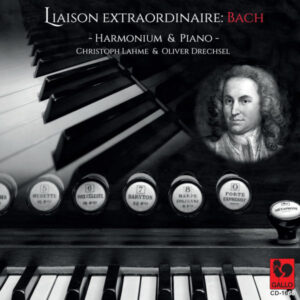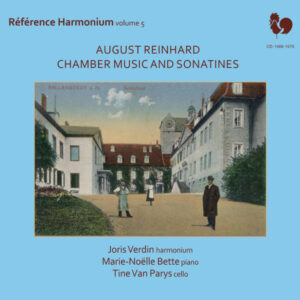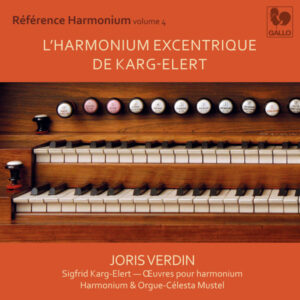Extraits / Excerpts
Mendelssohn: Liaison Extraordinaire for Harmonium-Piano duo - Christoph Lahme - Oliver Drechsel
Mendelssohn: Liaison Extraordinaire for Harmonium-Piano duo Overture Ruy Blas, Op. 95 – The Hebrides Overture, Op. 26 – Christoph Lahme – Oliver Drechsel
Felix MENDELSSOHN: Overture Ruy Blas, Op. 95, MWV P15 (Arr. for Harmonium-Piano duo by A. Reinhard) – Organ Sonata No. 4 in B-Flat Major, Op. 65, MWV W59 (Arr. for Harmonium-Piano duo by C. Lahme): III. Allegretto – The Hebrides Overture, Op. 26, MWV P7 “Fingal’s Cave” (Arr. for Harmonium-Piano duo by A. Reinhard) – Piano Concerto No. 1 in G Minor, Op. 25, MWV O7 (Arr. for Harmonium-Piano duo by A. Reinhard): II. Andante – Overture “A Midsummer Night’s Dream”, Op. 21, MWV P3 (Arr. for Harmonium-Piano duo by A. Reinhard) – Violin Concerto in E Minor, Op. 64, MWV O14 (Arr. for Harmonium-Piano duo by A. Reinhard): II. Andante – Herbstlied, Op. 63, No. 4, MWV J11 (Arr. for Harmonium-Piano duo by C. Lahme) – Elias, Op. 70, MWV A25, Pt. 1 (Arr. for Harmonium-Piano duo by C. Lahme): For He Shall Give His Angels – Symphony No. 4, Op. 90, MWV N16 (Arr. for Harmonium-Piano duo by O. Drechsel): I. Allegro vivace.
Christoph Lahme, harmonium
Oliver Drechsel, piano
“[…] it has wonderfully beautiful stops, with which one can embellish chorales. I am delighted by the heavenly flowing sound of the instrument – in particular, Fanny, I have found the stops which lend themselves best to playing Seb. Bach’s Schmücke dich, o liebe Seele. It seems as if they were made for this purpose alone, and the sound is so moving that any time I start to play it makes me shiver. For the florid accompaniment I have an 8 ft. flute and a perfectly soft 4 ft., which continues floating above the chorale itself – you would recognise this from Berlin. But there is one manual that has all manner of reed stops, and of these I use a soft oboe, a clarion, a very light 4 ft., and a viola. That brings out the chorale so quietly and piercingly, as if it were distant voices singing from the bottom of their hearts.”
This enthusiastic account of the reed stops on the manual of the physharmonica in St. Peter’s Church in Munich is from a letter Felix Mendelssohn Bartholdy wrote to his sister Fanny on October 6, 1831. The physharmonica is one of many instruments which preceded the harmonium; it had free reeds that made it possible to add dynamic nuance with varying air pressure, though it could not be played as expressively as the later harmonium.
Yet Mendelssohn was also familiar with other predecessors of the harmonium aside from organs, the so-called orgue expressif. Whether through his acquaintance with Sigismund Neukomm or as a regular guest of Freiherr von Bunsen, these early orgues expressifs obviously failed to inspire Mendelssohn to compose for them himself. Perhaps this was due to his fairly off-putting encounters with existing compositions, such as the experience detailed in a letter he wrote to his mother from Paris on March 25, 1825:
“Neukomm (who seems to teach very well) accompanied them [the vocalists of a Stabat Mater] on an orgue expressif, a newly developed instrument with a gamba stop which can be made to swell and fade using the bellows. Between every piece of the fairly dry, yet melodic composition, he played a cantus firmus and added different harmonies every time. That did not work! It became increasingly monotonous, the more it changed, the more tedious it became. It ended with a fugue. Brrrr!”
Mendelssohn’s enthusiasm for reed stops has found its way into the various arrangements of his compositions on this CD, featuring harmonium and piano that manage to convey the impression of an orchestral sound but in a small chamber music setting.
The captivating Overture to Ruy Blas, here in a congenial arrangement by August Reinhard (1831–1912), is one of Mendelssohn’s more happenstance works. He details its development in a letter to his mother, written on March 18, 1839, in Leipzig:
“You wanted to know how the overture came about – it’s funny enough; six to eight weeks ago, I received a request to compose an overture and a romance for a performance organised by the Theaterpensionsfonds (a very good and charitable institution here that wanted to put on Victor Hugo’s Ruy Blas as a charity event), because they hoped to raise more money with my name in the title. After reading the play, which is so terribly lacking in any merit whatsoever, I said I would compose a romance but did not have any time for an overture. The premiere was on Monday (eight days ago today); then on Tuesday, I was politely thanked for composing the romance, but what a shame that I hadn’t written an overture – they could understand that a work of that nature would take time to compose, and they would, if I allowed, ask me further in advance next year. This bothered me; Cécile had a cold and was in bed by 9 in the evening, so I thought about it and started my score. Wednesday rehearsals all morning, Thursday concert, and by Friday morning the entire overture was with the copyist, Monday it was rehearsed three times in the concert hall and once in the theatre. That evening it was played as part of the infamous play, and I enjoyed it so much more than most of my other works.”
In Christoph Lahme’s arrangement of the Allegretto from the 4th Organ Sonata op. 65, it’s the harmonium that dominates with a dialogue of melodies in soprano and tenor ranges, both voices weaving into each other. The concept is very similar to that of the “Duet,” the song without words op. 38/6, composed for solo piano. Another “Duet without words” from 1836 provided the basis for the Herbstlied (Autumn Song) op. 63/4, which Mendelssohn rearranged for two voices and piano accompaniment in 1844, set to a text by Karl Klingemann. For musicologist R. Larry Todd, this composition is “fascinating evidence for Fanny’s claim that as children, the siblings had had ‘fun […] writing text for your playful songs.’” Christoph Lahme’s arrangement, which returns to an instrumental version, designates both vocal melodies to the harmonium, the higher in the baritone register, the lower the bassoon.
When Walter Scott published his collection of Highland poems The Lady of the Lake in 1810, his romantic idolisation sparked veritable Scottland-mania throughout Europe. Countless artists were inspired by Scott, not least Franz Schubert (Hymne an die Jungfrau). Those who had the necessary funds travelled themselves and visited the respective sights, as did Mendelssohn, accompanied by his friend Karl Klingemann.
“This is what I came up with so you could get a sense of how peculiar I felt on the Hebrides,” Mendelssohn wrote to his family in Berlin on August 7, 1829 [See facsimile on inside flap of digifile]. His sister Fanny responded, “That makes sense… so that’s why both violins say F# for so long.”
Mendelssohn initially wanted to call his Concert Overture “Die Hebriden” (The Hebrides) ‘Overture to the Lonely Island’, in reference to the island Staffa and its legendary Fingal’s Cave. He would usually draw sketches for his diary or travel journals, but unfortunately no such drawing exists of this place so important to the Hebrides overture. Despite a calm sea that day, Mendelssohn became terribly seasick. But at least his impressions found their way into a sound-painting still popular today; Richard Wagner praised the composer’s skill as a “first-class landscape painter”, while Johannes Brahms stated, “I would give all of my works in return for the ability to compose an overture like Mendelssohn’s Hebrides.”
Christoph Lahme / Oliver Drechsel, August 2024
- Categories
- Composers
- Interprets
- Booklet













